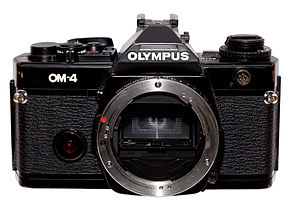Olympus OM-4
| Olympus OM-4 | |

|
|
| Type: | single-lens single-lens reflex camera |
| Production period: | 1984–1987 (presented 1983) |
| Lens connection : | Olympus OM bayonet |
| Film format : | 35 mm (small picture) |
| Recording format : | 24 × 36 mm (small picture) |
| Viewfinder : | Pentaprism finder with Fresnel lens, diopter correction −3– + 1 |
| Viewfinder field: | 97% |
| Enlargement: | 0.84 times |
| Finder Ads: | Bar display of shutter speeds from 1–1 / 2000 s in 1/3 f-stop steps; Over and under exposure warning; "+/−" display for manual measurement; Flash readiness (green LED); "Correct" flash exposure (flashing of the green LED); Exposure mode (spot / integral metering) |
| Operating modes: | Open aperture measurement, integral (center-weighted on shutter curtain - autodynamic), spot measurement via silicon measuring cells, 2% multi-spot measurement (maximum 8 points), high-key and low-key button (in spot mode) |
| Film transport: | manual or motorized (winder / motor) |
| Exposure metering : | TTL open aperture measurement with lenses from the OM system |
| Measuring range: | EV −7–19 (at 100 ISO - with the Zuiko Auto-S 50 mm f / 1.4) |
| Correction : | +/- 2 f-stops in 1/3 steps |
| Closure : | electronically controlled cloth closure (horizontal) |
| Shutter speed : | 1/2000 to 240 s, B, mechanical emergency time 1/60 s |
| Flash control: | TTL automatic, up to 9 Olympus T flash units can be ignited and controlled simultaneously |
| Lightning connection : | Standard ISO norm contact hot shoe (center contact) and 5-contact connection socket |
| Synchronization : | 1/60 s and longer |
| Power supply: | 2 × SR44 / LR44, test (LED and acoustic signal) |
| Dimensions: | 136 × 84 × 50 mm |
| Weight: | 540 g |
The Olympus OM-4 was presented at the PMA in Las Vegas in 1983, but was only available from 1984 and was built until 1987. It was the successor to the Olympus OM-2 and founded the new OM generation together with the Olympus OM-3 .
Light metering system
In addition to manual tracking measurement, the OM-4 offers automatic timing and TTL auto flash measurement. The camera measures the light falling through the lens using center-weighted integral measurement both before and during exposure. The measurement is carried out directly on the shutter curtain or on the film surface during exposure. Olympus calls this process autodynamic exposure control , or ADM system for short.
Thanks to the autodynamic measuring system, the camera can react directly to changed lighting conditions and also uses this technology to achieve extremely precise flash exposures. In addition, the camera offers spot metering and multi-spot metering, up to 8 measuring points can be combined into one measurement. The measurement is carried out by a silicon photodiode and covers approx. 2% of the image field. There are also highlight and shadow buttons for very light and very dark motifs.
In contrast to all other OMs, the OM-4 also offers a measured value memory, but this is limited to 60 minutes or is automatically deleted when the lens is changed. The bayonet of the camera has also been changed compared to its predecessor and includes a switch on the OM-4. This switch clears the measured value memory when the lens is changed. At the same time, this switch is a known problem with the OM-4, as it can get caught in a screw on the bayonet of lenses from other manufacturers and be damaged when changing lenses. Therefore, Olympus warned against the use of foreign lenses at the time.
As with the Olympus OM-3, the exposure is no longer displayed in the viewfinder using a needle, but via an electronic LCD bar display. The OM-4 was designed for professional use and accordingly integrated into an extensive accessory system.
Furnishing
In contrast to its predecessor, the OM-2n, the viewfinder of the OM-4 has a dioptric correction. Furthermore, the camera no longer has a separate off switch; the camera electronics are activated by pressing the shutter release button.
equipment
Camera drives
- Motor Drive : The Olympus OM system has Motor Drive 1 and Motor Drive 2. Both allow film transports up to 5 frames / second. The Motor Drive 2 also offers motorized film rewind. The following energy sources are available for the Motor Drives: NiCd pack (15 V), battery handle (18 V, for 12 batteries or rechargeable batteries of size AA), control unit with mains connection.
- Winder : The Olympus OM system includes Winder 1 and Winder 2. Winder 1 only offers single image recordings, while Winder 2 also offers series images with up to 2.5 images / second. The winders do not offer automatic film rewind.
Camera back panels
The standard rear panel can be exchanged for the following rear panels:
- OM data back wall: a back wall for imprinting the date, time and exposure data
- Feature film magazines: Magazines 1 and 2 for film material for up to 250 exposures.
Focusing screens
16 interchangeable types of focusing screens, from the full focusing screen to the version with cross-section / microprism ring. The focusing screens are changed by the lens bayonet.
Flash units
In the Olympus OM system there are several flash units with different characteristics.
Remote release accessories
There are a number of accessories available for remote control of the OM-4, such as: B. Remote release cable, etc.
literature
- Olympus OM instruction manual (German), no date
